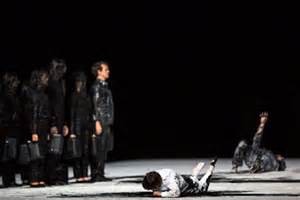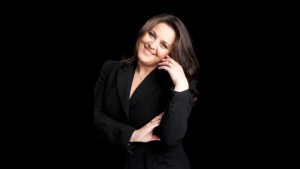On a ten-day visit to the City of Light I had the opportunity to attend two operas and one superb music rehearsal of three very different works. First came at the Opera de Bastille Laurent Pelly’s production of Donizetti’s Elisir d’Amore. Chantal Thomas designed the charming sets, and Joel Adams the contemporary costumes; the production was a revival.
Unusual for any theater in Europe, the production stuck to a traditional if modernized realization of the comedy, a decision which so suits this bucolic work. A huge haystack on which both Nemorino and Adina literally climbed up and down several times dominated the first scene. Nemorino occasionally did somersaults on it, while Adina climbed on it with aplomb. Dr. Dulcamara arrived in a huge truck (the setting was a small town in modern-day Italy), and in Act II choristers set up a platform for the dinner. The costumes looked perfect for today.
The opera always demands a great tenor, and the Paris Opera gave us one in Roberto Alagna. A major international artist for some years, he played Nemorino with more athleticism than any I can remember and had style, grace, and a uniformity of tone from top to bottom that was literally ideal. “Una furtiva lagrima” and really all that he did had a kind of freshness and skill that marks the great interpreters of the role. His Adina (and his wife in real life), Aleksandra Kurzac, sang brilliantly, looked like a million dollars, and never became unpleasant but only bemused at Nemorino’s actions. Her concern for him came through more palpably than often is the case. Her final aria,”Prendi” had color and charm in abundance. Ambrogio Maestri, last season a great Falstaff at the Metropolitan Opera, played a jovial, charming mountebank whose “Udite, o rustici” made the audience laugh. More important the speed and accuracy with which he dispatched Dr. Dulcamara’s coloratura showed him to be a master of the style. Mario Cassi played a solid Belcore, and Melissa Petit a pert Gianneta.
Donato Renzetti conducted with a real Italianate feeling and excellent rhythm. Nothing dragged or seemed rushed.
The first new production for the Paris Opera this season was Schoenberg’s Moses und Aron, the first premiere for the new General Director, Stephane Lissner, conducted by the Opera’s music director, Philippe Jordan.
The opera demands almost constant performance for the chorus, and it was said that the Opera’s chorus literally rehearsed the work for one year. They were brilliant as was the orchestra under Maestro Jordan’s dramatic and inspired conducting. In this complex opera the orchestra often seems independent of the singing, and Jordan kept the two in great balance, each making its own effect
Thomas Johannes Mayer and John Graham-Hall played Moses and Aron, respectively, with command and a clear understanding of the complex, twelve-tone style. Their grasp of the difficult music and ability to project it with meaning commanded respect.
The production by Romeo Castellucci portrayed a sterile and cold world. The first act was played almost entirely
behind a porous but visible scrim. At times it split horizontally, and one could see a little bit through it. The Israelites were all dressed in white. In the second part of the opera the scrim was raised. The dance around the Calf of Gold did not happen. What did occur was people pouring a black liquid over the white costumes of the chorus, making everyone black instead of white.
I know that the all the elements were strong and the effort put forth extraordinary. Unfortunately, I have never connected to this opera, and this production did not change my feelings.
What I did love was the opportunity to attend a music rehearsal (for principals only and with piano) of Bellini’s Norma at the Champs-Elysees Theater. The opera will receive its premiere on December 8 and will have five performances through December 22. From what I heard anyone who loves opera should be there.
I was invited to the rehearsal by Maestro Riccardo Frizza who led with vigor and a firm grasp of Bellini’s style. So often the conductor of bel canto operas, even Norma, is ignored, and in fact if he is invisible, he probably is carrying out what was expected by Bellini. In fact, conducting Norma is harder than works composed later in the nineteenth century because Bellini (like most composers of the period) gave few instructions. Everything depends on the communion of the conductor with the singers, great on this occasion.
The Norma, Maria Agresta, and the Adalgisa, Sonia Ganassi, made the day more than remarkable. Ganassi is well known for this role, and she lived up to her considerable reputation: her high notes and low notes equally powerful and easy, she displayed superb phrasing, the long Bellini line, and a warmth of voice throughout rare to encounter. Possessed of a slightly dusky mezzo, she used a variety of colors from dark to brilliant, making her a worthy partner to Norma.
Agresta has sung the Druid priestess in four previous productions. Her voice rich, beautiful and perfectly produced, her coloratura easy and accurate, and her phrasing and grasp of the long Bellini line all made her interpretation extraordinary. What mattered more was her ability to project the Druid Priestess’ varied emotions and a meaning for every word. The command of her first great recitative set the tone. Moving then from a perfectly intoned “Casta Diva” and a glittering and powerful cabaletta to the final note of the opera, she sang a Norma to conjure with. She never tired. Both her declaration of guilt (“Son io”) and the subsequent finale (even without the orchestra or the chorus) moved me tremendously.
In both the great duets of Norma and Adalgisa their voices blended marvelously, the two colors distinct yet united as ideally happens in this great opera.
Riccardo Zanellato sang Oroveso powerfully, strong in both the opening “Ite sul colle” and particularly effective in “Ah! del Tebro” in the final scene. Sophie Van de Woestyne offered a good Clothilde. The Pollione, Marco Berti, had been released from this rehearsal to sing elsewhere.




Leave a Reply